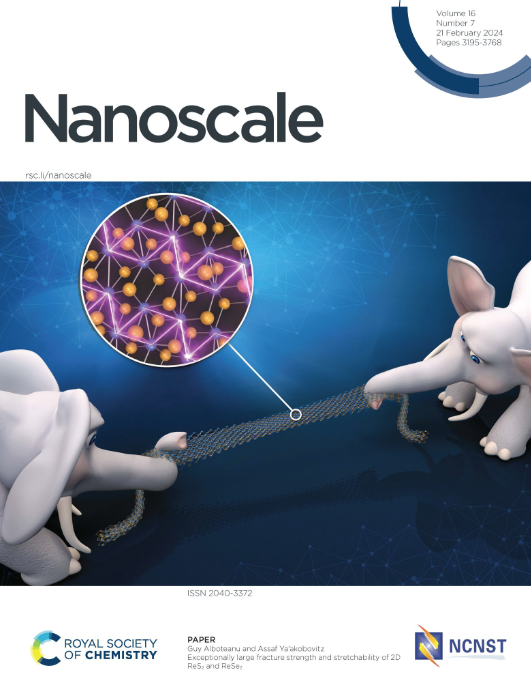Graphene Oxide/Niobium Carbide MXene Composite-Based Functional Nanocomposite Scaffold for Artificial Cornea
IF 5.8
3区 材料科学
Q1 CHEMISTRY, MULTIDISCIPLINARY
引用次数: 0
Abstract
Artificial cornea offers the only hope to end-stage cornea disease patient. A highly desirable artificial cornea requires high mechanical strength, good biocompatibility, sufficient durability to withstand hostile environment and possesses specific biological activities. This study reports the physical characteristics, cytocompatibility, and biocompatibility of nanocomposite by graphene oxide and niobium carbide MXene (GO/Nb2C) used in normal rabbit cornea and corneal alkali burn model. Nanoindentation and long-term corrosion assay in combination with atomic force and scanning electron microscopy were used to study mechanical properties and corrosion resistance. In vitro biocompatibility was evaluated based on the survival, proliferation, and attachment of human corneal stromal cells. In vivo stability and host tissue responses were conducted using GO/Nb2C scaffolds implanted inside rabbit corneas and in a vivo corneal alkali burn model. Fibrosis index Hsp47, FN, and a-SMA were negative. Furthermore, IL-2 and IL-6 were downregulated, along with oxidative stress indices in the rabbit cornea after implanting GO/Nb2C scaffolds. In vivo corneal alkali burns model, IF indicated GO/ Nb2C scaffolds decreased CD11b expression around surgical area. The GO/Nb2C scaffolds have significantly high biocompatibility with biological activity, safety, efficacy, antioxidative stress, and anti-inflammatory property. This promising bioactivity corneal scaffold provides new ideas for constructing a functional scaffold of artificial cornea.基于氧化石墨烯/碳化铌MXene复合材料的人工角膜功能纳米复合支架
人工角膜是终末期角膜疾病患者的唯一希望。一种理想的人工角膜需要高的机械强度、良好的生物相容性、足以承受恶劣环境的耐久性和具有特定的生物活性。本研究报道了氧化石墨烯和碳化铌MXene纳米复合材料(GO/Nb2C)的物理特性、细胞相容性和生物相容性,并将其用于正常兔角膜和角膜碱烧伤模型。采用纳米压痕法和长期腐蚀法,结合原子力法和扫描电镜法研究了材料的力学性能和耐蚀性。通过对人角膜基质细胞的存活、增殖和附着进行体外生物相容性评价。采用GO/Nb2C支架植入兔角膜和在体角膜碱烧伤模型研究其体内稳定性和宿主组织反应。纤维化指数Hsp47、FN、a-SMA均为阴性。此外,植入GO/Nb2C支架后,兔角膜内IL-2、IL-6及氧化应激指标均下调。在角膜碱烧伤模型中,IF显示GO/ Nb2C支架降低手术周围CD11b的表达。氧化石墨烯/Nb2C支架具有明显的生物相容性,具有生物活性、安全性、有效性、抗氧化应激和抗炎性能。这种具有良好生物活性的角膜支架为构建功能性人工角膜支架提供了新的思路。
本文章由计算机程序翻译,如有差异,请以英文原文为准。
求助全文
约1分钟内获得全文
求助全文
来源期刊

Nanoscale
CHEMISTRY, MULTIDISCIPLINARY-NANOSCIENCE & NANOTECHNOLOGY
CiteScore
12.10
自引率
3.00%
发文量
1628
审稿时长
1.6 months
期刊介绍:
Nanoscale is a high-impact international journal, publishing high-quality research across nanoscience and nanotechnology. Nanoscale publishes a full mix of research articles on experimental and theoretical work, including reviews, communications, and full papers.Highly interdisciplinary, this journal appeals to scientists, researchers and professionals interested in nanoscience and nanotechnology, quantum materials and quantum technology, including the areas of physics, chemistry, biology, medicine, materials, energy/environment, information technology, detection science, healthcare and drug discovery, and electronics.
 求助内容:
求助内容: 应助结果提醒方式:
应助结果提醒方式:


